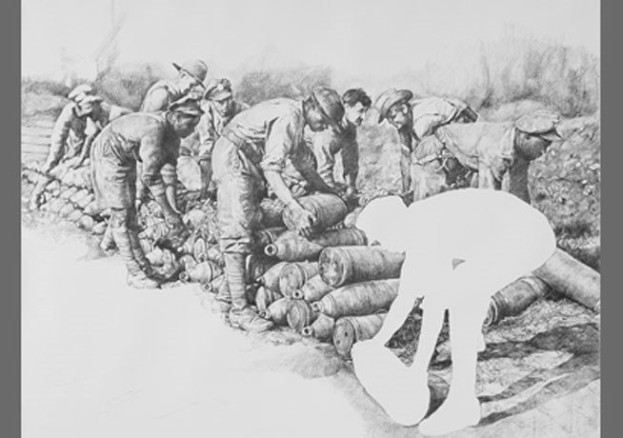
Featured on the first floor of the Midland Arts Centre in Cannon Hill Park, Barbra Walker’s free exhibition ‘Shock and Awe’ focuses on the lack of representation in Historical wartime coverage for Black servicemen and servicewomen, despite their large and wholly necessary support for Great Britain during both World Wars and has continued to this day.
The one room exhibition features a mix of charcoal, canvas, paper cuttings and direct-to-wall compositions, which means that the sheer number of pieces on display makes the room feel well used. However, like the theme of the exhibition, the space used also makes you feel like you are merely on the tip of the iceberg on what the artist has to say on the subject of representation and erasure.
One of the many exhibition highlights is actually featured outside of the exhibition room, whetting your appetite for what is to come. Featured just to the right hand side of the entrance door is a short video featuring the Artist and one of her works; although what it is and what it is called does not matter, as the video features Walker washing away- by hand, a charcoal drawing which seems to take up the entirety of a warehouse wall. This video beautifully encapsulates what is inside, as the obvious metaphor for the intentional erasure of people of colour is poignant and at no point are you allowed to forget it.
For those who are not used to seeing Black African and West Indian citizens being documented during the First and Second World Wars, Walker manages to make the pieces feel familiar, engaging and informative whilst the distinctly missing pieces within the work tell a story within the story of the piece itself; that Black people have been systematically erased when it comes to recalling any time period with regards to war.
Walkers entire exhibition is dedicated to acknowledging the absence of representation for Black people over the past 100 years and due to the fact it does not deviate from the subject matter makes the exhibition ever more powerful.
An interpretation to take away from the exhibition is that the Artist is deliberately trying to represent people of colour during a period of over the past 100 years, but the missing pieces are almost as if a third party is deliberately removing pieces and by doing so, we will never see the complete picture- the truth.
An alternative interpretation is that a third party is withholding the piece, and whilst the image is incomplete, through time, we can finish it and have a complete picture in time.
These two interpretations are only two of many that you can come away with as the individual pieces are uniquely distinct, even if they may be fragments of a larger, overlapping theme and direction.
The contrast between unique individuality and collective importance makes Shock and Awe moving, enchanting and somewhat liberating; to see that people like us, were still important during the 1900’s, even if we may never see or be recognised for our contributions.
